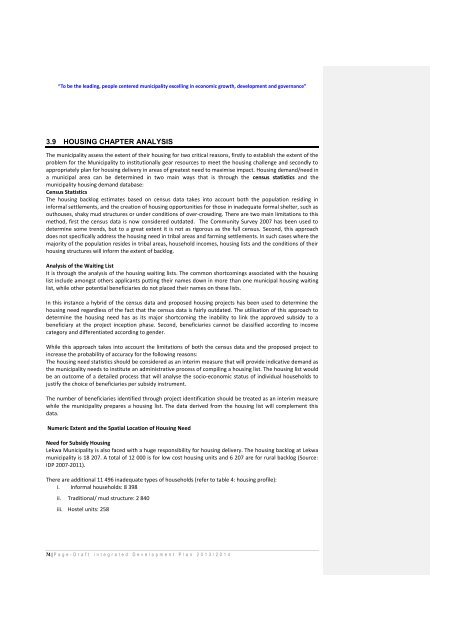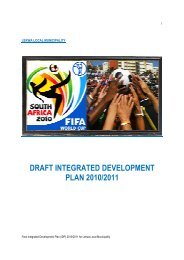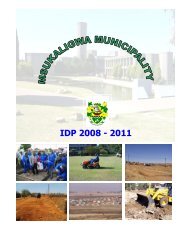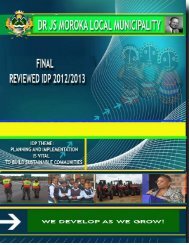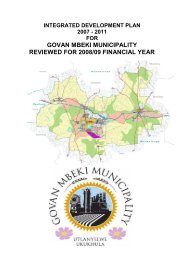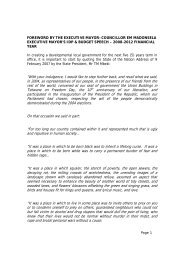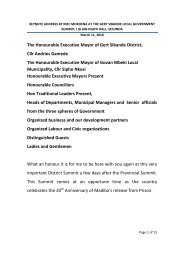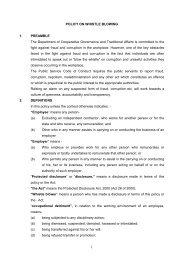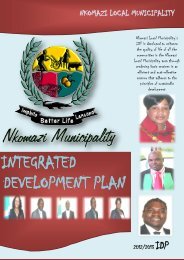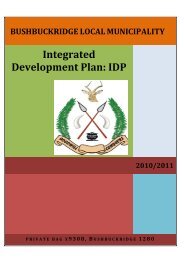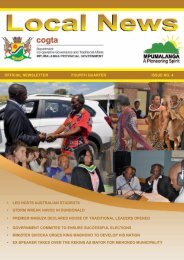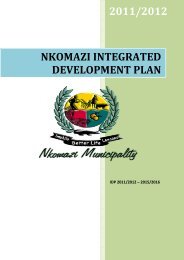Lekwa Local Municipality 2013/14 - Co-operative Governance and ...
Lekwa Local Municipality 2013/14 - Co-operative Governance and ...
Lekwa Local Municipality 2013/14 - Co-operative Governance and ...
Create successful ePaper yourself
Turn your PDF publications into a flip-book with our unique Google optimized e-Paper software.
“To be the leading, people centered municipality excelling in economic growth, development <strong>and</strong> governance”3.9 HOUSING CHAPTER ANALYSISThe municipality assess the extent of their housing for two critical reasons, firstly to establish the extent of theproblem for the <strong>Municipality</strong> to institutionally gear resources to meet the housing challenge <strong>and</strong> secondly toappropriately plan for housing delivery in areas of greatest need to maximise impact. Housing dem<strong>and</strong>/need ina municipal area can be determined in two main ways that is through the census statistics <strong>and</strong> themunicipality housing dem<strong>and</strong> database:Census StatisticsThe housing backlog estimates based on census data takes into account both the population residing ininformal settlements, <strong>and</strong> the creation of housing opportunities for those in inadequate formal shelter, such asouthouses, shaky mud structures or under conditions of over-crowding. There are two main limitations to thismethod, first the census data is now considered outdated. The <strong>Co</strong>mmunity Survey 2007 has been used todetermine some trends, but to a great extent it is not as rigorous as the full census. Second, this approachdoes not specifically address the housing need in tribal areas <strong>and</strong> farming settlements. In such cases where themajority of the population resides in tribal areas, household incomes, housing lists <strong>and</strong> the conditions of theirhousing structures will inform the extent of backlog.Analysis of the Waiting ListIt is through the analysis of the housing waiting lists. The common shortcomings associated with the housinglist include amongst others applicants putting their names down in more than one municipal housing waitinglist, while other potential beneficiaries do not placed their names on these lists.In this instance a hybrid of the census data <strong>and</strong> proposed housing projects has been used to determine thehousing need regardless of the fact that the census data is fairly outdated. The utilisation of this approach todetermine the housing need has as its major shortcoming the inability to link the approved subsidy to abeneficiary at the project inception phase. Second, beneficiaries cannot be classified according to incomecategory <strong>and</strong> differentiated according to gender.While this approach takes into account the limitations of both the census data <strong>and</strong> the proposed project toincrease the probability of accuracy for the following reasons:The housing need statistics should be considered as an interim measure that will provide indicative dem<strong>and</strong> asthe municipality needs to institute an administrative process of compiling a housing list. The housing list wouldbe an outcome of a detailed process that will analyse the socio-economic status of individual households tojustify the choice of beneficiaries per subsidy instrument.The number of beneficiaries identified through project identification should be treated as an interim measurewhile the municipality prepares a housing list. The data derived from the housing list will complement thisdata.Numeric Extent <strong>and</strong> the Spatial Location of Housing NeedNeed for Subsidy Housing<strong>Lekwa</strong> <strong>Municipality</strong> is also faced with a huge responsibility for housing delivery. The housing backlog at <strong>Lekwa</strong>municipality is 18 207. A total of 12 000 is for low cost housing units <strong>and</strong> 6 207 are for rural backlog (Source:IDP 2007-2011).There are additional 11 496 inadequate types of households (refer to table 4: housing profile):i. Informal households: 8 398ii. Traditional/ mud structure: 2 840iii. Hostel units: 25874 | P a g e - D r a f t i n t e g r a t e d D e v e l o p m e n t P l a n 2 0 1 3 / 2 0 1 4


